What is necessary for a "hybrid digital" work model to succeed in the next normal?
Our analysis of global surveys reveals five factors that companies should strengthen
The COVID-19 pandemic caused a shock that required companies to switch to remote work immediately. Fortunately, the forced digitalization of work also resulted in higher productivity, employee satisfaction, and sometimes even business model changes.
So far, however, the changes in workstyles have only been tested during extraordinary conditions. Now is the time to future-proof workstyles and think about how to transform them for the next normal. Which additional changes will be necessary for the more hybrid environments of combined office and remote work?

In this article, Dr. Martin Schulz and Dr. Jürgen Brock from Fujitsu look at workstyles before and during the pandemic based on Fujitsu's own experience and a number of global surveys. We analyze the results of two large digital workstyle survey in Japan and Germany before the pandemic and contrast them with the recommendations of Fujitsu’s “Work Life Shift” for future workstyles with more “smart working,” a “borderless office,” and a broader “culture change.” The results provide very interesting insights into how companies need to upgrade their current workstyles for the next normal.
- Were companies able to respond well to changes in the business environment caused by the pandemic?
- Results of Fujitsu's own work style reforms and regional differences
- What is the new way of working in a post-pandemic?
- Five important factors to strengthen toward the next normal
- Survey Demographics and Methods
Were companies able to respond well to changes in the business environment caused by the pandemic?
During the pandemic, we witnessed how organizations can digitally operate, survive, and even thrive under extreme circumstances. As a response to the pandemic in our own company, Fujitsu has developed a “Work Life Shift” initiative that helped to build a more adaptive and resilient enterprise by transforming the way we work. After delivering stellar results in internal practices, Fujitsu now hopes to support its customers during a successful transformation of digital workstyles for the "next normal” as well.
Fujitsu is a digital company, however. What do other business leaders really think about their pandemic response?
To find out, we reviewed global digital transformation surveys to identify opportunities and challenges of the new digital workstyles during the pandemic. We found that companies were mostly happy with the forced changes, but remained concerned about necessary changes in business models, employee satisfaction and customer relations at the frontline.
Our “Global Digital Transformation Survey Report 2021”, for example, shows that 78% of executives were satisfied with their response to the changes in the business environment caused by Covid-19*1.
In this survey, we separated “digital” companies, who are operating online, from more “traditional” companies, who run much of their business “offline.” Among digital companies, 79% saw their revenues increase during the pandemic, while more traditional companies often saw their revenue decrease (53% of companies). Under pressure, most traditional companies (82%) accelerated their digital transformation despite the challenges. As a result, a large number of traditional companies saw improvements in customer experience, business agility, efficiency, and competitiveness.
The digital success for customer experience and productivity, however, was not matched by similar progress in business model transformation and employee satisfaction, which is important for the move towards the “next normal.” Only 23% of companies saw an impact of their transformation on business models, and only 15% found improvements in employee satisfaction.
Graph 1: Global Digital Transformation Survey – Outcomes
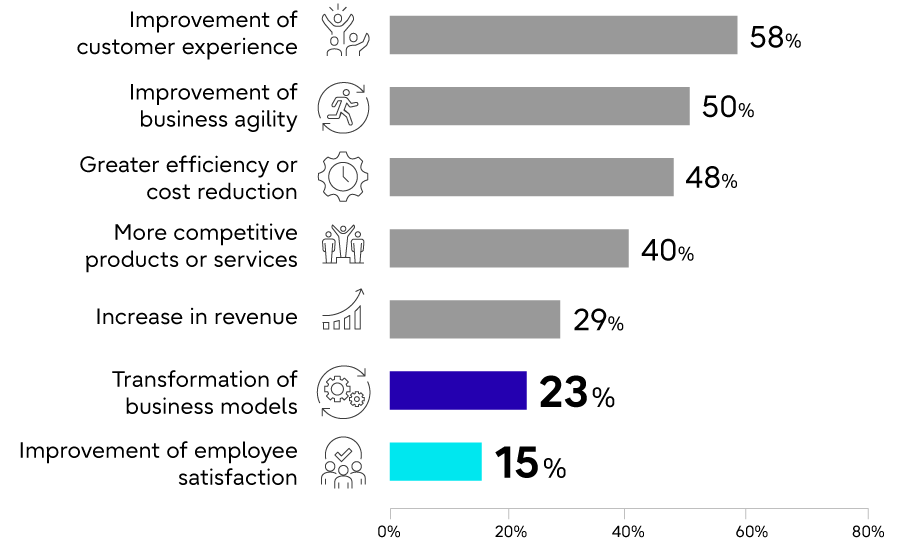
Source: Fujitsu - Global Digital Transformation Survey Report 2021.
Another in-depth survey of business leaders in the UK raised some additional concerns about the long-term challenges of workstyle transformation*2. Business leaders pointed out that customer demands have been changing at tremendous speed and keeping up with them created a major challenge. Adapting their business models to new demands in customer experience (CX) has been difficult for them.
Furthermore, the UK survey also revealed some frustration among employees at the front-line. More than half felt that delivering excellent service had become more difficult, and 60% found that selling to new customers was difficult when working online. While their work environment had changed during the pandemic, their workstyles had not caught up. More than half of the executives therefore thought that more changes would be necessary when preparing for the “next normal” after the pandemic. Supporting mental health, the right balance of positive feedback and necessary scrutiny, as well as a very high level of security has been on the top of their minds when working on the transition for the “next normal.” Potentially, these transformation challenges could become further complicated because a staggering 87% believed that their employees would prefer complex hybrid working arrangements after the pandemic.*2
Implementing digital workstyles in the next normal, it seems, remains to be challenging and often requires a significant culture shift. In many cases, strong leadership might not be enough when internal resistance to change returns after the pandemic.
According to McKinsey & Co, 70% of change-programs fail to achieve their goals*3. When employees are genuinely invested in change, on the other hand, it is more likely to stick. External disruption, crisis, and urgency to change can therefore be an important motivator to accept and support necessary changes in workstyles, office organization, and business models.
This is why we believe that the current pandemic has some silver lining. It is hard to imagine a larger “external shock” that results in broad acceptance for digitalization and new workstyles. Setting the new digital workstyles on a sustainable basis and leveraging them to become part of the corporate fabric, however, seems to require further and lasting preparation.
Results of Fujitsu's own work style reforms and regional differences
As a second step, we analyzed survey results of Fujitsu’s internal new workstyle practice to get a better understanding of potential opportunities and challenges.
Since Fujitsu embarked on its own “Work Life Shift” well over a year ago, we already had some data to work with. While Fujitsu’s “Work Life Shift” has been a huge success, we also found some concerning regional differences and challenges, however. To improve on these, we wanted to make sure that our digital work transformation model works across countries and cultures.
As one of Japan’s digital leaders, Fujitsu had a long history of digital work transformation before the pandemic, of course. It also had all the tools and infrastructure that are necessary for a successful digital shift at its disposal. Nevertheless, the pandemic has been a huge shock for Fujitsu, too. To make use of the crisis in the most constructive way, management wanted to provide additional tools for smart working and for lifting online and offline boundaries to make work as worthwhile and productive as possible. For the “next normal,” it was important that employees can focus on new value creation while being part of an agile and resilient organizational culture.
Fujitsu’s Work Life Shift has been realized with solutions that have been tied together in three key categories: "Smart Working," "Borderless Office," and "Culture Change."
Planned as a disruption, the transition has gone surprisingly smoothly, not least because work had already been disrupted by the pandemic, and Fujitsu, as an IT company, had been well prepared. Internal surveys show that 27% of employees saw an immediate increase in productivity. Many also saw a temporary decline in their productivity, however.
The biggest improvements have been reported related to commuting (65%), workstyles and systems (41%), as well as the family environment (including childcare) at 20%. Among the specific productivity measures, clarification of job descriptions (59%) and improvements in communication (54%) had the strongest positive impact. Employees were also happy about changes and upgrades to responsibilities (49%) and independent workstyles (45%).
These changes had different impact in different regions, however. In its Central Europe operations (in and around Germany), for example, only 19% of employees saw an increase in productivity, while many even reported a decline in efficiency during the pandemic. Following up on these regional differences has become an important part of the transformation project.
The digital work transition during the pandemic succeeded surprisingly well. The digital transformation that has been triggered by the pandemic “shock”, however, can only be a starting point. It will require further digital workstyle and culture changes in the next normal, especially for companies that have been working more traditionally before the pandemic.
What is the new way of working in a post-pandemic?
To find the best solutions that would work in the “old” and the “new” normal, we proceeded in three steps.
First, we have built a “Digital Work Transformation Model” based on our experience with the “Work Life Shift.” This model represents the new digital workstyles that we found to be successful after the digital shift during the pandemic.
Second, we tested this model against the background of two large pre-pandemic digital work surveys in Japan and Germany. The hypothesis was that if the “new” work model is a good fit for the data of the “old normal,” we have a strong indication that our digital work model will also work well when companies return to normal operations in the “next normal.”
Finally, we tried to further improve the new Digital Work Transformation Model with additional supportive factors that we found in the “old” work environments of Japan and Germany.
For our tests, we went back to two large digital work surveys that we did before the pandemic across a broad range of mostly traditional companies in Japan and Germany. In these surveys, we asked a large number of (90+) questions about the realities in corporate work environments related to digital work transformation (see “Survey Demographics and Methods” below).
At first glance, the difference between companies and countries in these surveys were large. Compared to Japan, Germany was far ahead in terms of most indicators of digital workstyles.
This is in line with most international digitalization surveys. In the IMD World Digital Competitiveness Ranking 2021, for example, Germany is ranked as number 18 and Japan as number 28*4. In Japan, we also found a very large gap between “digital leaders”, and more traditional companies, which explains much of the poor ranking of Japan in international surveys.
Digital Work Transformation Model
The resulting “Digital Work Transformation Model” is pictured below.
Graph 2: Digital Work Transformation Model
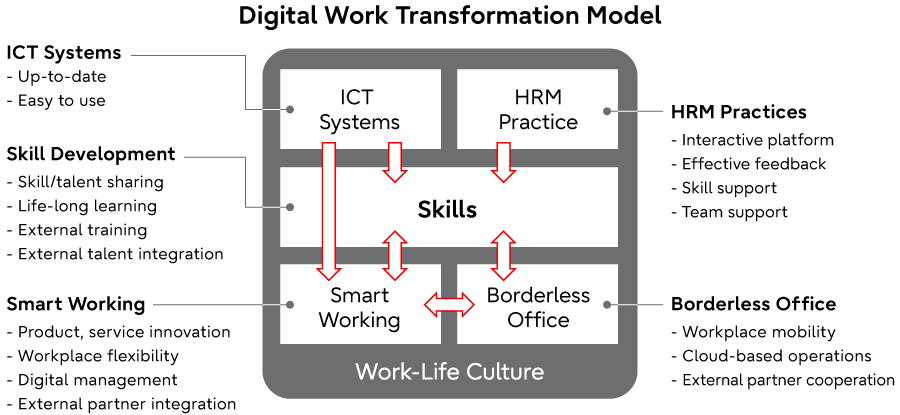
The model is based on Fujitsu’s three Work Life Shift factors “Smart Working,” “Borderless Office,” and “Culture Shift.” Since we found additional, supporting factors in the surveys, however, we have added them to the model. “ICT Systems” includes positive results for regular system upgrades (within two years) and user friendliness. “HRM Practice” includes the availability of digital and interactive Human Resource Management platforms, as well as skill and team building support. The central factor “Skill Development” includes support for talent sharing, life-long learning, and external training integration. They were all found to be supportive to the Work Life Shift factors and need to be considered as an important part of workstyle transformation.
The model consists of so called “factors,” which are constructed by combining closely related variables. The factor “Borderless Office” in the lower right corner, for example, consists of answers about the availability of workplace mobility, cloud-based operations, and external partner cooperation. Perhaps most importantly, the arrows in the model show the dependencies between the different factors. As can be seen, “Smart Working” and “Borderless Office” are closely related and support each other. Both are also closely related to “Skill Development,” which, in turn, depends on effective “ICT Systems” and “HRM Practice.”
For the factor “Work-Life Culture” we had to take a short-cut when modeling it. Since we did not have enough matching survey questions to model “culture” appropriately, we defined “Work-Life Culture” as the sum of all other factors instead. In our view, this is less limiting than it seems. The included systems, skills, governance and workstyles factors certainly represent a major part of work-life culture, even without introducing additional elements.
Workstyles of Japanese and German Digital Leaders
We were surprised that the final model was explaining the differences between the companies in both of our survey countries so well. The differences in digitalization between companies and countries were, after all, quite big.
To illustrate, we have plotted the averages of positive replies for each factor in the graph below, and we have added a group of “digital leaders” for each country.
Graph 3: Factors of Digital Work Transformation in Japan and Germany
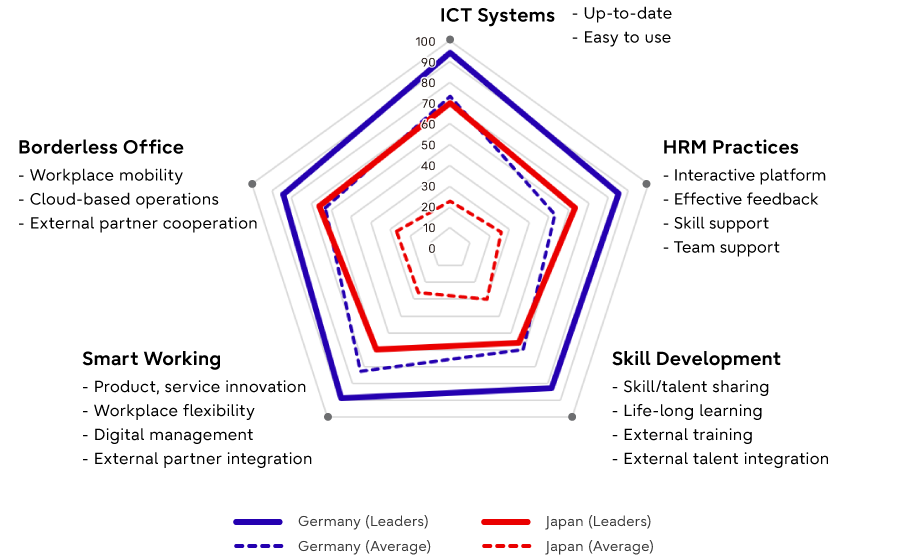
Note: Values are averages of positive replies for each factor
The gap between “average” companies and the “digital leaders” in Japan was indeed huge. Even Japan’s “leaders” only matched the average of German companies. The gap between Japanese and German leaders, on the other hand, was comparatively narrow.
While work-life cultures seem to have been quite different between more traditional companies in Japan and Germany, digital workstyles among digitally advanced companies seemed to be surprisingly similar even before the pandemic. This is good news for Japanese traditional companies who want to “catch up” with best practices in digital workstyles. They could just follow their more advanced peers at home, instead of looking for best practice abroad.
Matching “old” and “new” workstyles
As explained above, it was the goal of our project to test the “new” pandemic-based digital work models against the “old” reality before the pandemic. It is therefore perhaps not too surprising to find additional factors that are rooted in the more long-term realities of companies.
While the Work Life Shift focuses on the digital innovations during the pandemic, the pre-pandemic data remind us that supporting long-term operational changes might be necessary. Based on our survey results, “Skill Development,” which includes support for talent sharing, life-long learning, and external training integration, will be a very important enabling factor. Without appropriate skills, after all, no system can be operated, smart working is impossible, and borderless offices remain shut. The same is true for modern ICT systems, which are the basis of smart working, directly and indirectly.
We were a bit more surprised about the importance of effective HRM practice. When planning their long-term digital workstyles for the next normal, companies therefore should be aware that upgrades to their existing HRM practices might be necessary.
Five important factors to strengthen toward the next normal
When testing our model, we found that “smart working” and “borderless office” indeed explain much of the variation in our work-life data (see the R2 results of the model in the appendix). They depend on “Skill Development,” “ICT Systems,” and “HRM Practice” as enabling factors, however. Many traditional companies will also need to upgrade these important parts of work culture and operations to achieve their full potential in the “next normal.”
Since such significant changes in work practices should have a positive impact on business results, innovation, and employee engagement, we tested the final model against these hoped-for results.
The results have been very encouraging for Japan and Germany. When we tested the correlation between “Work-Life Culture” (the sum of all factors in the model) and survey results for positive “Business Outlook,” “Innovative Operations” and “Employee Happiness,” we found high to medium-high correlations results for all three variables. The strongest correlation was found to be for “Innovative Operations” in Japan, which might be the hoped-for result for many companies.
Graph 4: Correlations between Work-Life Culture and Business Results
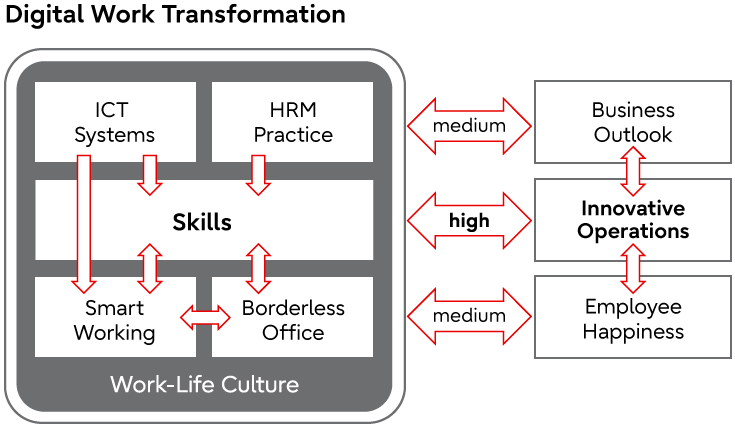
| Business Outlook | JP: 0.35 (medium) | GE: 0.39 (medium) |
|---|---|---|
| Innovative Operations | JP: 0.55 (high) | GE: 0.47 (medium/high) |
| Employee Happiness | JP: 0.46 (medium/high) | GE: 0.48 (medium/high) |
Note: Please see the correlations explanation below.
To summarize, we will point out some of the most significant empirical results for each factor in a little more detail.
- Modern ICT Systems are the basis
ICT systems are the basis for an effective work-life shift. The impact of ICT systems on work-life culture is indirect, however, it depends on employee skills development and smart work practices. The vast majority of “digital leaders” have modern ICT systems while laggards do not; in Japan even “average” companies are far behind. - Effective HRM Practices are important
Effective HRM practices are key elements of a successful work-life shift. Its main impact runs through the support of company-wide communication platforms and feedback. Close integration with skill development and team building is very important. Even leading Japanese companies seem to make limited use of integrated HRM/Skills/Communication platforms such as SAP SuccessFactors or Oracle Taleo so far. - Skill development is key
Skill development is the most important ingredient of a successful work-life shift. The effective use of ICT systems, the success of smart working and borderless office practices depend on strong employee skill development. E-learning already plays and important role in Japan, while Germany shows the important role of effective external partner integration. - Borderless office supports partner integration
Cloud-based operations are the foundation for a borderless office. A borderless office builds on skills of employees. External partner cooperation opens new potentials for smart work in the borderless office. Japanese leaders can build on a relatively high levels of cloud-based operations. - Smart working delivers transformation results
Smart working, or the effective digitalization of work, delivers the results of digital transformation. Effective digitalization improves management relations and product services. Companies gain from higher levels of innovation, efficiency, and flexibility. Smart work builds, however, on strong employee skills. German companies have achieved high levels of smart work practices, Japanese companies are lagging, which holds them back. - Digital Work-Life Culture is related to positive outcomes
The final outcomes of a successful Work-Life Shift are thought to be “Innovation,” “Employee Happiness,” and a positive “Business Outlook.” Individual factors in our model, such as “ICT Systems,” had only few direct correlations with these important outcomes, however. Isolated upgrades seem to be insufficient to have a significant impact on business results. Business results were, however, positively correlated to the overall model results. A successful shift in the “Work-Life Culture” might indeed result in positive results for innovation, employee satisfaction, and the business outlook.
We found that the main factors in Fujitsu’s Work Life Shift Initiative “Smart Working,” “Borderless Office” explained variations in our pre-pandemic surveys very well. A group of “Digital Leaders” in both countries has indeed been working smart and borderless even before the pandemic. We also found, however, that three additional factors of an effective digital work transformation need to be considered: Modern ICT Systems, effective Human Resource Management (HRM), and comprehensive Skill Development are all important to support the new workstyles. Together, these factors can add up to a digital “Culture Shift” that results in higher levels of innovation, positive business results, and employee happiness.
Survey Demographics and Methods
As basis for our model research, we used two large “Digital Transformation and Corporate Digital Skills” surveys that have been conducted simultaneously in Japan and Germany. The surveys were planned and directed in 2017/2018 at Fujitsu Research Institute (FRI). The survey interviews have been conducted online by Macromill Japan.
The surveys consisted of more than 90 questions, and targeted 1,200 employees at medium to large companies (>500 employees, 45% of respondents in leadership roles) across industries in Japan and in Germany.
Questions were asked in Japanese and German, and responses were analyzed based on a four-point Likert scale. Questions were asked as follows: For each statement below, please choose the answer that is the closest to your understanding of your work/company: “My company’s IT systems are easy to use;” “Digitalization improves my workplace flexibility;” …
Some modification has been necessary to deal with cultural biases in the two countries. Most importantly, we did not allow standard midpoint “neither/nor” responses to avoid a Japanese bias for midpoint responses. After the survey, we also aggregated “strongly agree / disagree” and “agree / disagree” replies to adjust for different levels of intensity of response styles (German replies were more biased towards “strongly agree” than Japanese replies).
The “Digital Work Transformation Model” was developed as part of an explorative factor analysis of the survey data. Common factors and correlations have been identified by using Partial Least Square analysis. The models for Japan and Germany have been estimated separately with a confirm sample each. In the graph, coefficients in blue are for the German model and in red for Japan. The arrows depict the path coefficients of the correlations. The strength of the arrows is relative to the correlation coefficient. “Business Outlook,” “Innovativeness” and “Digital Leader” have been modeled as exogenous factors.
Graph 5: Digital Work Transformation Model dependencies
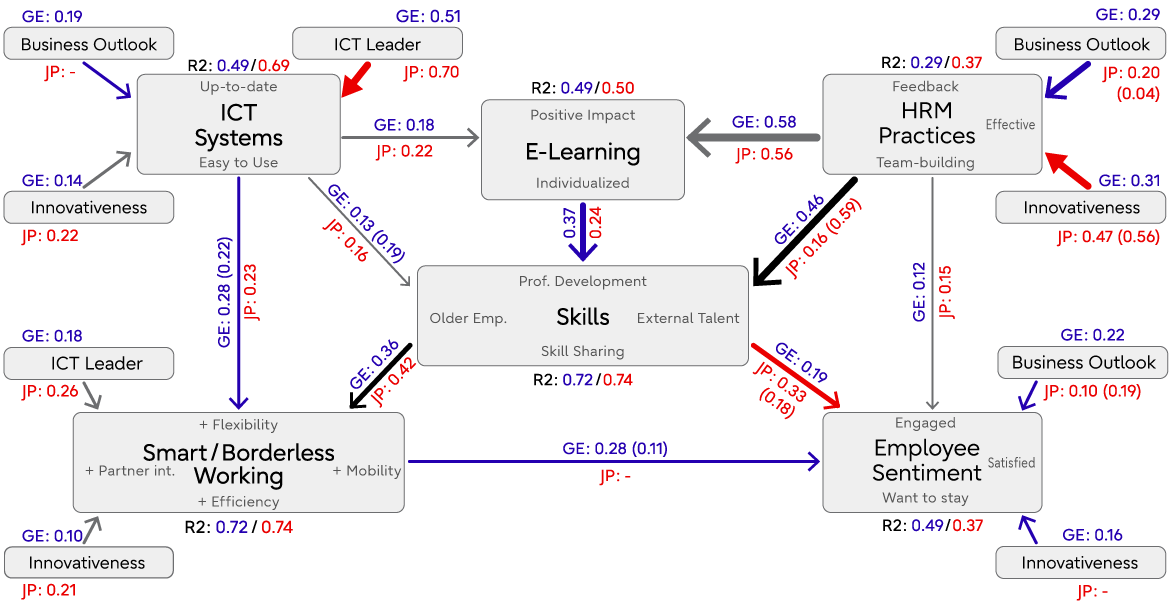
Note: Partial Least Square Model. Coefficients in brackets are from a confirm sample when significantly different. Goodness of Fit: 0.57/0.61
Graph 4 shows the Pearson correlation coefficients for the estimates of each variable. To estimate correlations between the model results for “Work-Life Culture” and the exogenous variables for “Business Outlook,” “Innovative Operations” and “Employees Happiness,” we aggregated the model results in one variable. The “Work-Life Culture” variable was constructed by adding the results of the five factors Smart Working, Borderless Office, Skill Development, ICT Systems, HRM Practice.
About the author

Dr. Martin Schulz
2021 Fujitsu Ltd., Global Marketing Unit, Chief Policy Economist
2000 Fujitsu Research Institute, Senior Research Fellow
- "How Has the COVID-19 Pandemic Changed the Future?"
- "Workstyle Reforms and Digital Transformation Opportunities", FRI Opinion, May 23, 2018

- "Brexit, EU Reform and the Crisis of Globalization", FRI Opinion, July 14, 2016

- "The Future of Structural Reforms in Japan and Germany", FRI Opinion, March 23, 2016


Dr. Jürgen Brock
2021 OC fulfillment GmbH, CEO
2011-2021 Fujitsu Ltd., Global Marketing Unit, General Manager
- Were companies able to respond well to changes in the business environment caused by the pandemic?
- Results of Fujitsu's own work style reforms and regional differences
- What is the new way of working in a post-pandemic?
- Five important factors to strengthen toward the next normal
- Survey Demographics and Methods




